Taste of Morocco: Savoring City’s Secrets
Embark on a culinary journey through Morocco’s vibrant souks and aromatic kitchens, where every dish tells a story of culture and tradition!
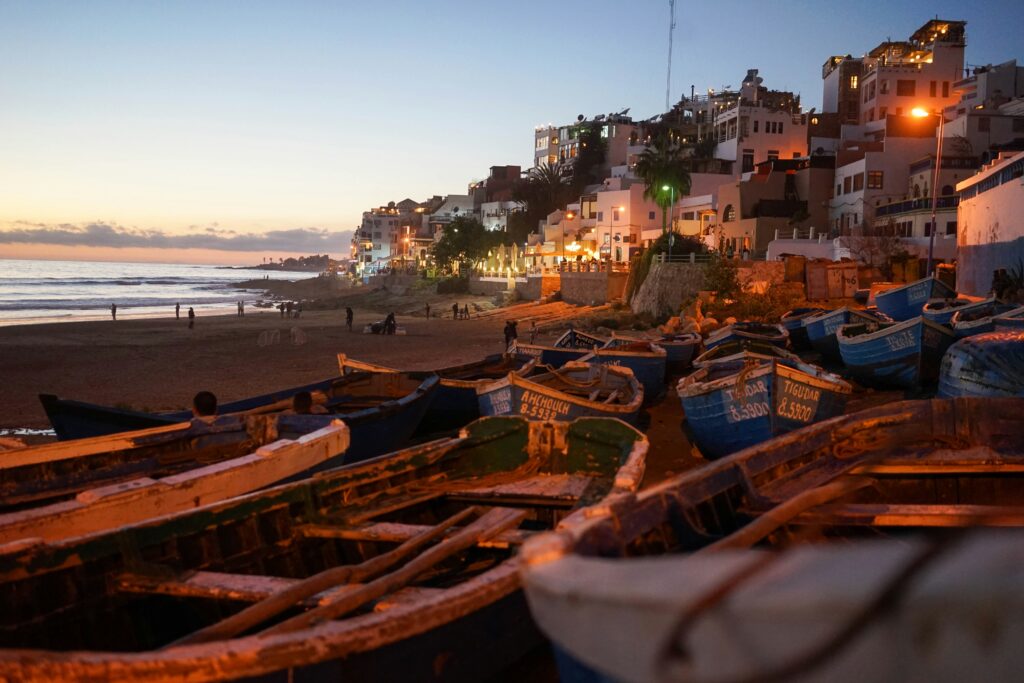
Morocco, a gateway to Africa and a country of dizzying diversity, invites you on a culinary journey that promises to delight your senses and leave your taste buds enchanted. Known for its colorful landscapes, bustling marketplaces, and rich historical tapestry, Morocco also boasts a culinary culture that is as varied as it is complex. From the time-honored tagines of Marrakech to the sizzling street food of Casablanca, each region offers a unique taste profile, reflecting the local customs, climate, and history.
The true essence of Moroccan cuisine lies in its intricate blend of spices, herbs, and textures—an intersection of Berber, Arab, Andalusian, and Mediterranean influences that together form a tapestry of flavors. As you wander through the ancient medinas, you are greeted by various scents guiding you toward gastronomic wonders. From the tangy zest of preserved lemons to the earthy punch of cumin and the sweet smell of cinnamon, these notes make Morocco’s culinary symphony.
The Spice Routes of Flavor
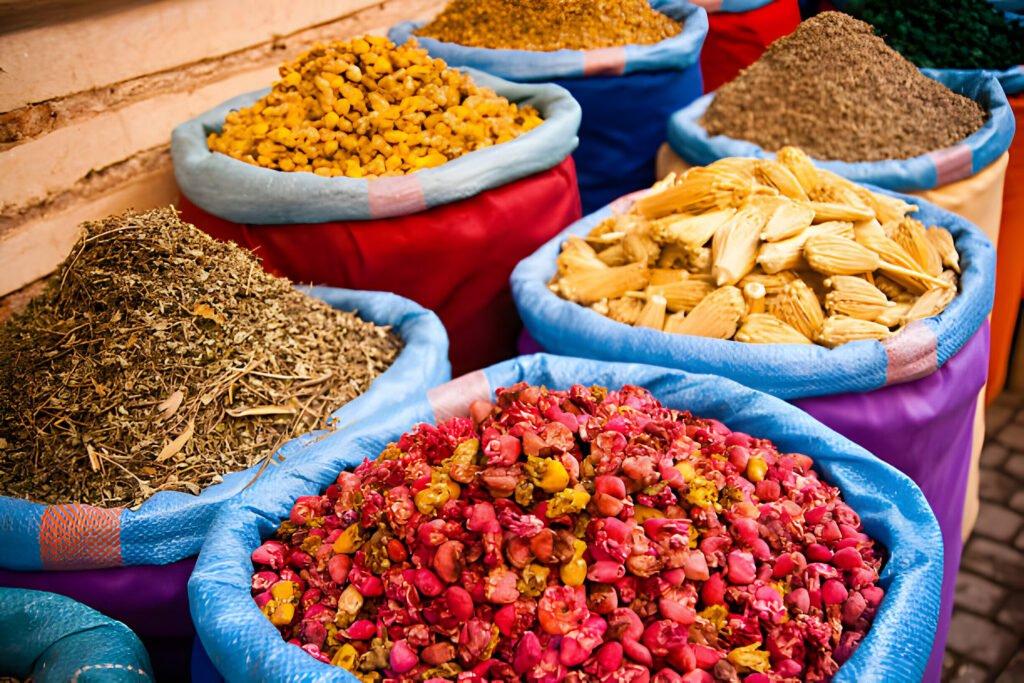
Moroccan cuisine is a testament to its history as a cultural crossroads. The influence of the spice trade is evident in the complex flavor profiles of dishes like ras el hanout — a spice mix that encapsulates the essence of Moroccan cooking with its blend of over a dozen herbs and spices.
When one speaks of ras el hanout, which translates to “head of the shop,” it refers to the very best the spice merchant has to offer.
This illustrious mixture is never static, often embodying the individuality of the merchant’s own secret recipe — in some variations, up to 80 different spices may blend to create an aromatic mosaic unmatched in any other global cuisine. These spices don’t just add flavor but also color and warmth, which are emblematic of the vibrant souks where they are sold.
And it’s not just ras el hanout that tells the story of Morocco’s storied past; each spice has its own tale. The fiery red paprika is reminiscent of the Andalusian influence, while the piquant ginger hints at trade links with the Far East.
Cumin, coriander, and cinnamon — each echoing the Arab and Berber heritage— play key roles in everyday dishes, their presence a homage to the ancient caravans that once weaved through the arid deserts and rugged Atlas Mountains to bring these prized flavors to Moroccan pantry shelves.
Intriguingly, the spices of Morocco are employed not only for their taste but also for their healing properties.
This is a land where food and medicine overlap, where turmeric isn’t just used for its earthy flavor and vibrant color in a dish but also for its anti-inflammatory benefits, celebrated in local folk medicine. Every pinch of spice in the Moroccan kitchen brings with it whispers of these ancient practices, blending the lines between nourishment, flavor, and well-being.
The cultural significance of each spice blend is palpable as one wanders the souks. The spectacle is a dance of colors and fragrances. In every market, behind each steaming tagine, within the walls of each riad, the spice routes continue to flavor not just the food but the very air, inviting one to taste and partake in the ongoing story of Morocco’s vibrant heritage.
Tagine, the Pinnacle of Moroccan Slow Cooking
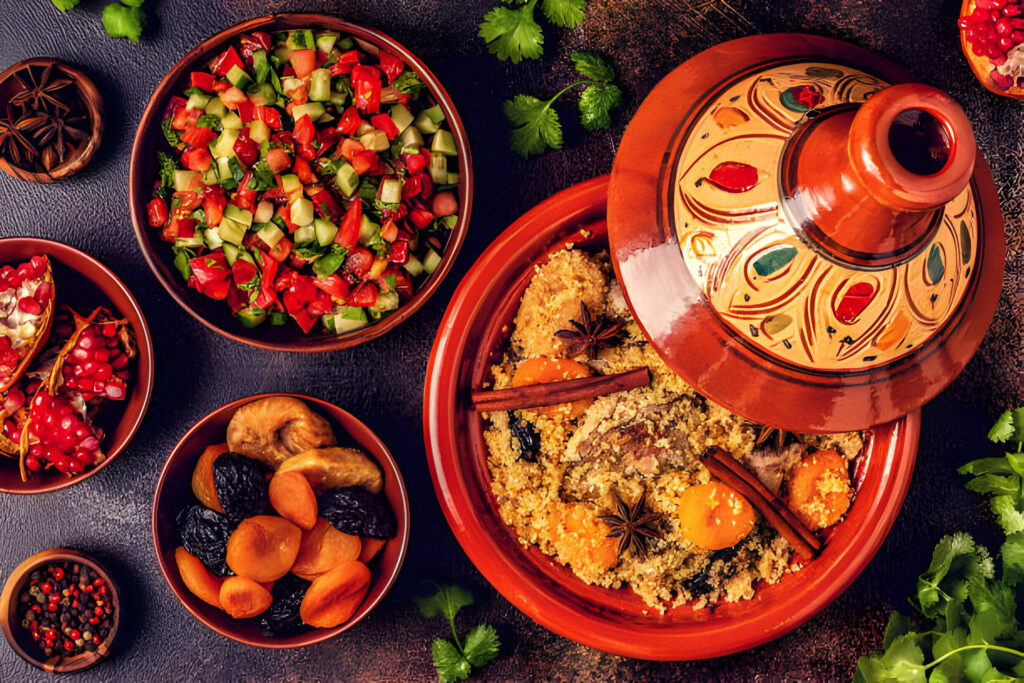
The tagine is both a culinary dish and the conical clay vessel it’s prepared within. This slow-cooking method, unique to North African cuisine, combines meats and vegetables with aromatic spices to create tender, richly flavored stews. The tagine is more than a mere cooking apparatus; it is a symbol of Moroccan hospitality and ingenuity.
A single tagine dish can tell much about Morocco’s culinary culture, from the regional variations in ingredients to the communal tradition of gathering around the dish and sharing bread and stories.
Infused with a profusion of spices such as saffron, cumin, and cinnamon, the stewed concoctions simmered gently in these earthen vessels encapsulate the diverse agricultural bounty of Morocco’s landscape.
The low and slow cooking process is a testament to patience, each steamy breath from the tagine unveiling a layer of flavor developed over hours. As families and friends convene around a bubbling tagine, its contents stewed to perfection, it becomes clear that this iconic dish is a medium of storytelling, connection, and shared heritage, evoking a sense of community with every fragrant spoonful.
From Olives to Argan: The Oil Essentials of Moroccan Kitchens
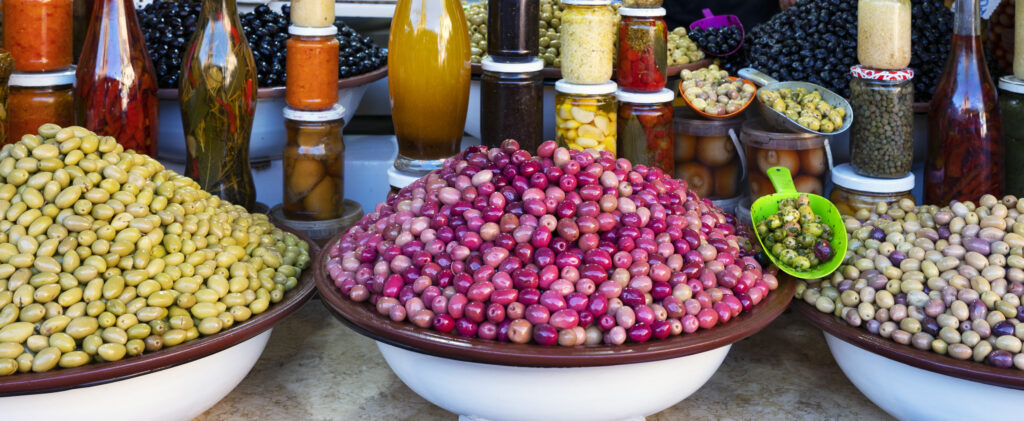
Olive and argan oils are two vital ingredients in Moroccan cuisine, deeply rooted in the country’s agricultural heritage. Olive oil is central to both cooking and preserving foods, while the rarer argan oil adds a distinctive nutty flavor to dishes.
The lore of Moroccan olive and argan oils stretches across millennia, with olive groves and argan trees deeply entrenched in the rolling landscapes.
These oils are not just culinary staples; they are also crucial to local economies and ways of life, particularly for Berber communities. Olive oil is the liquid gold that graces every meal, imbuing dishes with a fruity, peppery depth, while argan oil, often hand-pressed by Berber women, lends its luxurious, nutty essence to both sweet and savory creations.
Beyond their place in the kitchen, these oils are emblems of sustainability and female empowerment. They drive a significant part of the rural economy and preserve age-old traditions through cooperative work.
Moroccan Street Eats: A Tapestry of Tastes in Every Corner
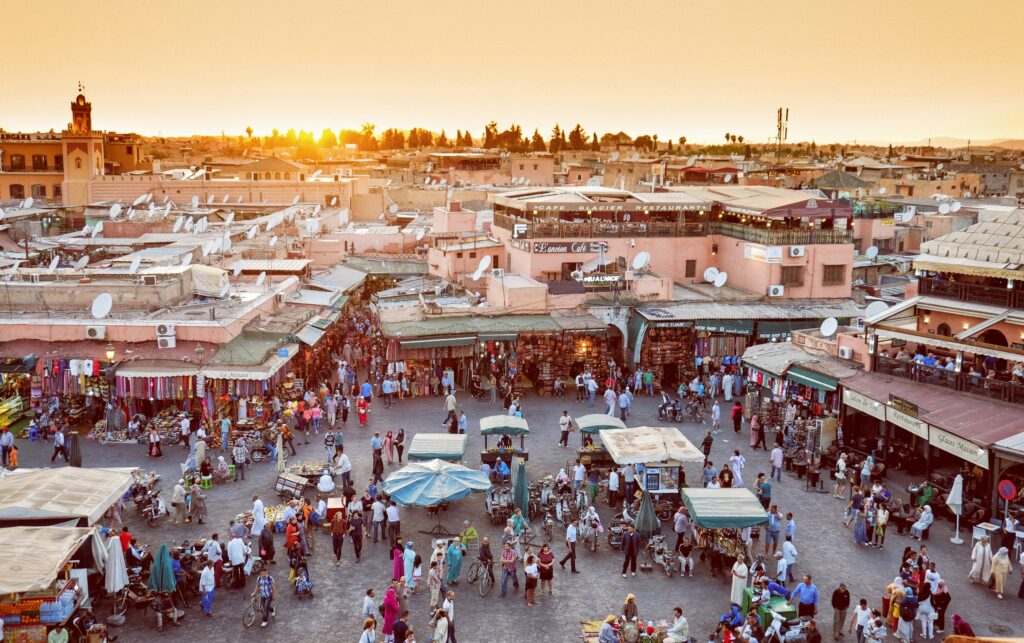
The labyrinthine streets of Morocco’s cities are lined with vendors and open-air markets offering an enticing array of street foods. From the sizzling merguez sausages to the sweet stalls selling honey-drenched pastries like chebakia, these foods provide an authentic taste of Moroccan life. There, culinary delights become a daily celebration, reflecting the grassroots of Moroccan gastronomy.
The air is rich with the smoke of grilled kefta, mingling with the sweet aroma of mint tea brewing at a nearby café. It’s a place where food is the pulse of the community, and every bite tells the story of the land and its people.
Savory sfihas open up dialogues with sweet honeyed briouats, showcasing the balance of flavors that Moroccan cuisine is famed for. As artisans expertly fold dough and grill meats, their deft hands are like conductors orchestrating an edible symphony that’s been perfected over generations.
Bread and Pastries: The Sustenance and Delight of Moroccan Cuisine
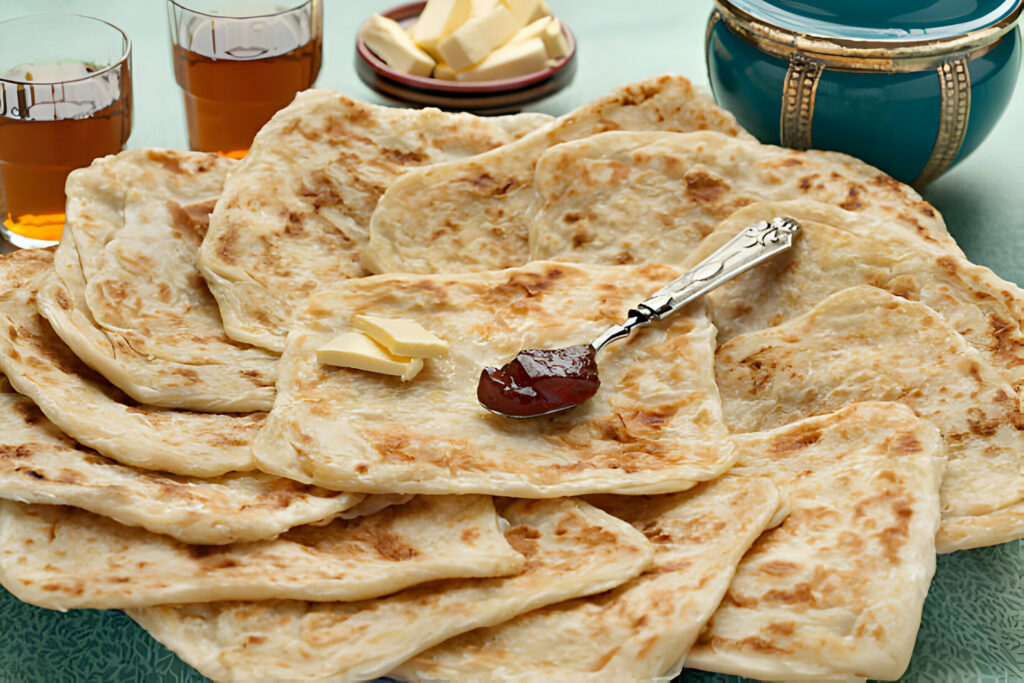
Bread, or khobz, is the cornerstone of Moroccan cuisine and is present at virtually every meal. In addition to its staple status, Moroccan bakeries exhibit a variety of bread types and pastries, each with a distinct form and flavor. From the flaky layers of msemen to the rich, almond-filled pastries served at celebrations, the diversity of Moroccan baked goods is a window into the artful skill of local bakers.
This craftsmanship of Moroccan bakers handed down through countless generations, finds its expression in the daily bread-making ritual. Khobz, with its crusty exterior and soft, warm center, acts as both utensil and sustenance, humbly accompanying the myriad of Moroccan dishes. The morning streets are perfumed with the scent of freshly baked bread, serving as a signal to the community that a new day has begun.
Celebratory occasions are also marked by the presence of sweet, sticky pastries like baklava, which are not just treats but symbols of hospitality, offered to guests with pride and joy as a showcase of Moroccan generosity and artistry.
The Ceremonial Mint Tea: More Than Just a Drink
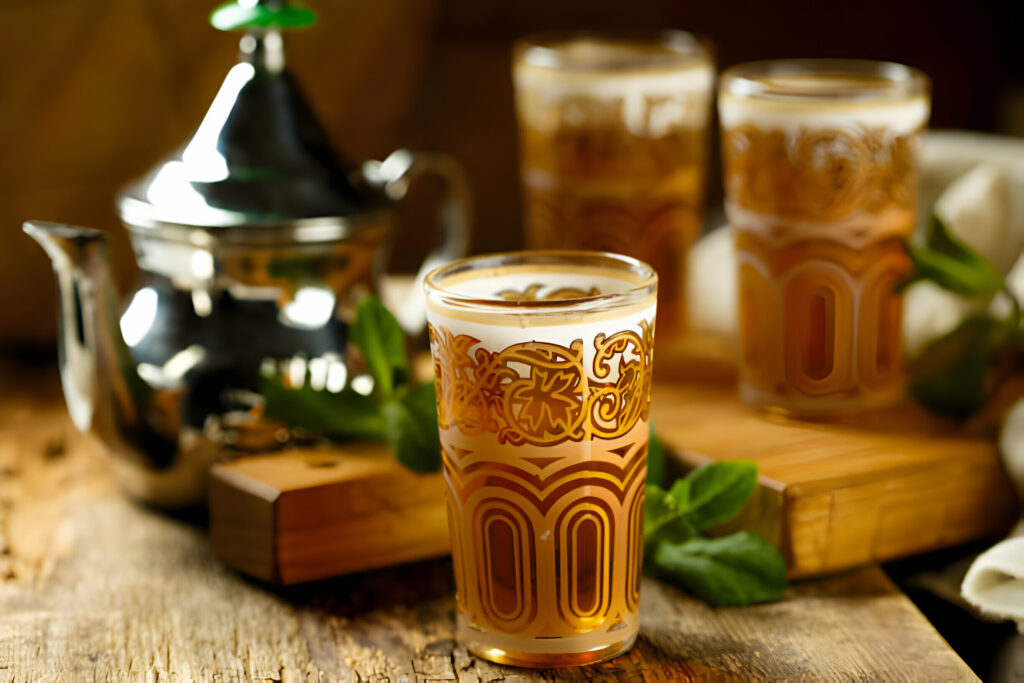
Mint tea in Morocco is not merely a beverage; it’s a ceremonial act of hospitality, friendship, and tradition. Preparing and serving mint tea is an art form, often performed with great flourish. Within the Moroccan mint tea ritual lies an intricate ballet of gestures and etiquette that symbolizes respect and camaraderie.
The steaming pot, which is often ornately crafted, is presented with a flourish of fresh mint leaves crowning the brew, their verdant aroma mingling with the scent of green tea and sugar. This libation, poured from high above to capture the spirit of generosity and skill, initiates conversations and seals friendships.
It’s a liquid tapestry of the nation’s identity, with each sip offering a silent acknowledgement of the Moroccan principle of convivial hospitality and the shared pleasure that transcends mere refreshment. Every glass is a toast to the country’s gracious spirit and the time-honored traditions that make every cup a cherished cultural experience.
The Tradition Remains
As we draw the curtain on the culinary stage of Morocco, the fragrant stories and warm traditions of this land continue to simmer in our minds like a perfectly seasoned tagine. Moroccan cuisine and culture is not just a feast for the palate or curiosity; it’s a narrative that unfolds on the tastebuds, revealing tales of bygone caravans, sun-soaked terroirs, a rich and beautiful city, and bustling medinas.
The country’s appetite for life is mirrored in the generous drizzles of olive and argan oil, the hearty embrace of fresh bread, and the communal sharing of mint tea, all of which are steeped in history, culture, and a deep sense of belonging.
The secrets we’ve savored go beyond mere ingredients and flavors—they are stories of a nation’s soul, shared over generations. They are invitations to communal tables, where food is not just nourishment but an expression of hospitality, culture, and unity. To truly know Morocco is to understand its love affair with food — a relationship steeped in tradition and sprinkled with innovation.
“Live life with no excuses, travel with no regret”
– Oscar Wilde
As you depart from this land of contrasts, take with you not just memories of the flavors you’ve tasted but also an appreciation for the patience and passion that infuses every dish. May the warmth and generosity that are the hallmarks of Moroccan hospitality continue to resonate with you long after the last bite.

